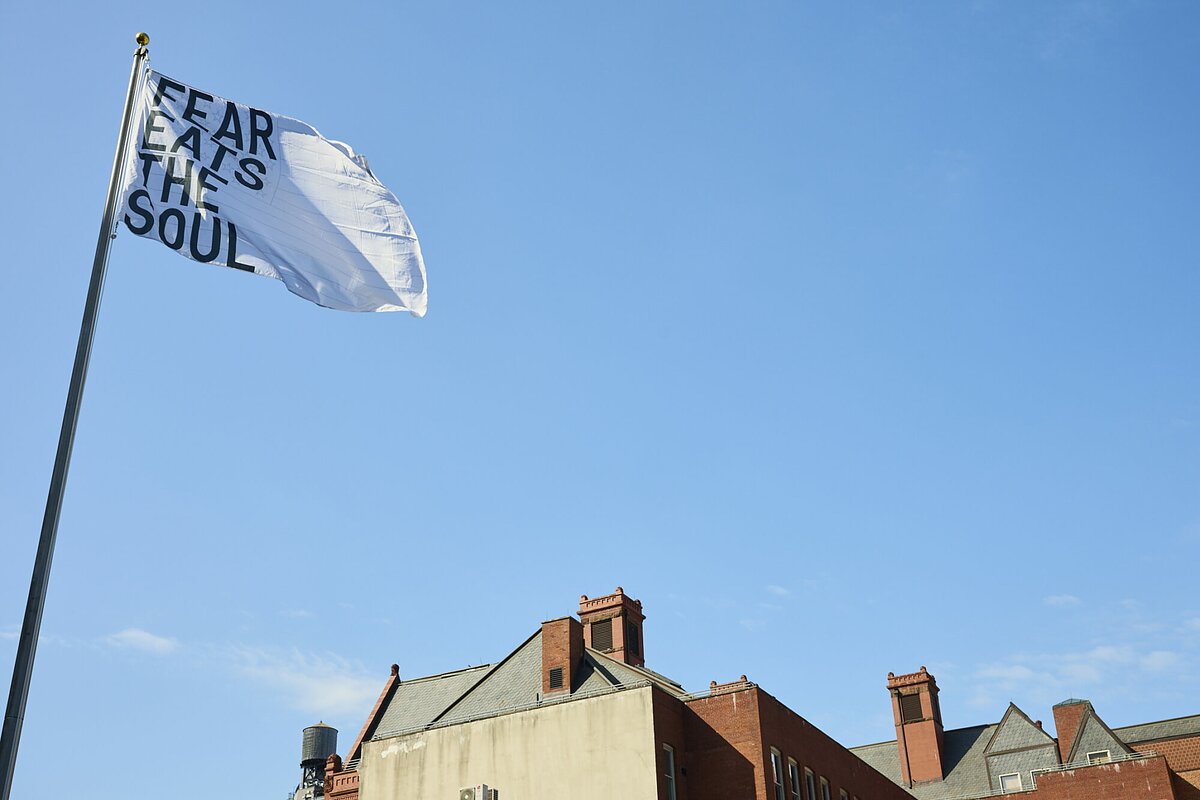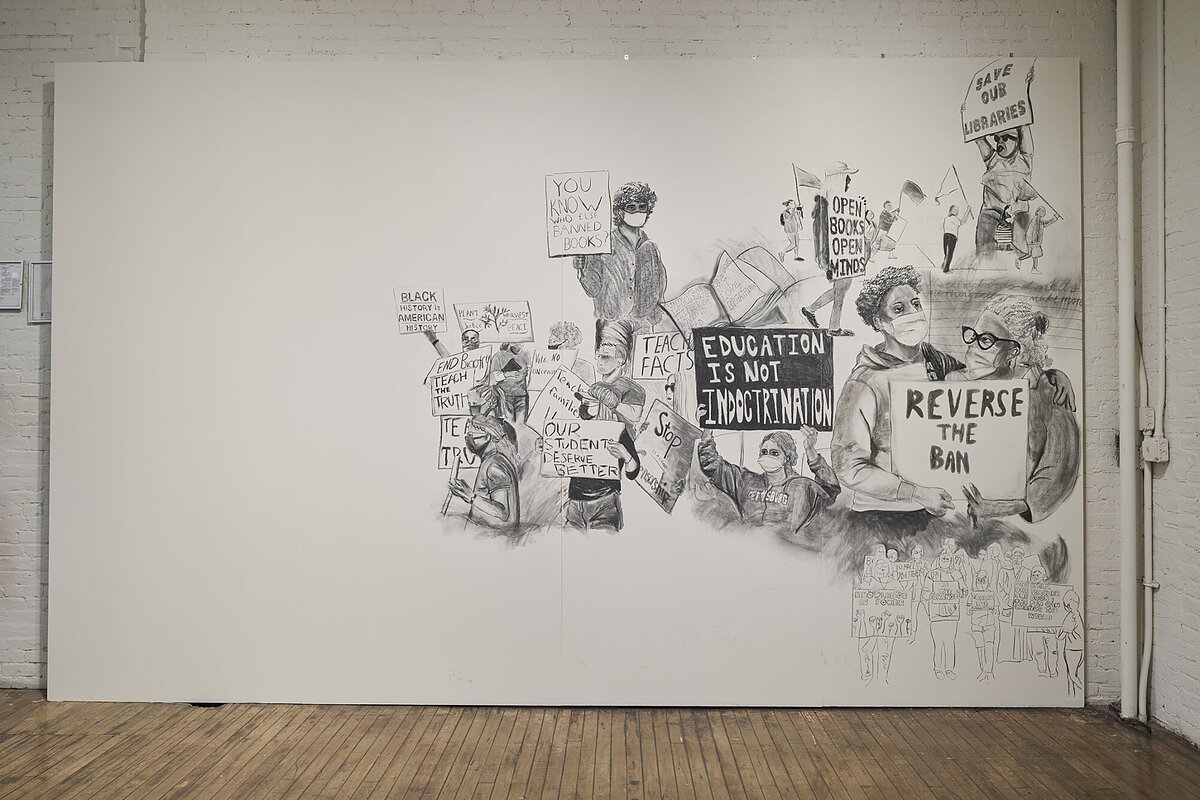“Rirkrit Tiravanija: A LOT OF PEOPLE” Invites Us to Reimagine Possibility
Flying high above the cold concrete walls of MoMA PS1 is a raised white flag that reads “Fear Eats the Soul”, a text that feels uncomfortably urgent given our current moment in history. This is likely the first work of Rirkrit Tiravanija’s that visitors will encounter when visiting, “Rirkrit Tiravanija: A LOT OF PEOPLE,” the largest exhibition of his work to date.
The sprawling show brings together over 100 works spanning four decades of the artist’s critically significant career, delivering an immense diversity of the artist’s practice, ranging from post-studio explorations, performative situations, film, painting, sculpture, and more.
Woven together by their inquiries into collaboration, cultural difference, and temporality, the works on view also reflect on Tiravanija’s diasporic experience (he is Thai, born in Buenos Aires, and raised between Chiangmai, New York City, and Berlin) as well as his impulse to invert apparatuses of power. As a result, “A LOT OF PEOPLE” encourages dialogue about navigating through otherness amongst familiar and unfamiliar communities in a dynamic milieu of worldly events and social conditions.
Entering the exhibition, one is immediately confronted by a striking mural titled (up against the wall motherfuckers) composed of bold tracings depicting political actions that are continuously updated throughout the exhibition’s duration. Echoing down PS1’s hallway are the sounds of bouncing ping-pong balls and light-hearted laughter. These sounds lead visitors to the first-floor balustrade overlooking the basement gallery where museum-goers can be found enjoying Tiravanija’s untitled 2021 (mañana es la cuestión), a black ping-pong table emblazoned with the work’s parenthetical title (“tomorrow is the question,” in English); alongside a large-scale digital print documenting Tiravanija’s recreation of Július Koller’s 1970 performance, Universal Futurological Question Mark, an arrangement of participants in the shape of a question mark in Zócalo, Mexico City.
The pairing of Tiravanija’s collaborative (up against the wall motherfuckers) and the participatory and semantic propositions of his basement installation call into question time and the role of people in creating artistic and political frameworks—especially ones that navigate between history, our current moment, and uncharted futures. These intersections of time and participation, particularly how one’s existence resides within a matrix of historical and everyday spaces, proliferate throughout the exhibition.
Scales of time and stamina challenge the audience’s relationship with spectatorship, like in untitled 2017 (super 8), an anthology of short films by the artist with a tremendous run-time of 499 minutes. The sheer volume of video works makes it impossible for viewers to watch all of the films in their entirety within a single visit to the museum. Similarly, Tiravanija’s untitled 1995-2007 (atlas I-VI), a series of photographs and print archives that map the artist’s amorphous practice, captures an ethos where the artistic process cannot be condensed into singularity but instead is an uncontainable force that we revisit in its multitudes of activations and formations.
Unlike traditional object-oriented practices, Tiravanija’s work fluidly expands its syntax by necessitating reimagination and introductions to new audiences and participants. To this effect, the mechanics of his oeuvre mirror our continuously unfolding world, rich with social dynamism that, in the artist’s words, “resists finality”.
On the second floor, an open gallery is dissected by a number of artworks that viewers are invited to engage with. In untitled 1992 (cure), a saffron cloth tent reminiscent of the clothing worn by Thai Buddhist monks shelters participants who are invited to sit and prepare a cup of tea. Elsewhere in the exhibition space is untitled 1996 (rehearsal studio no. 6, open version), an active recording studio where visitors can play musical instruments and record their sessions. Here, Tiravanija offers an opportunity to depart from traditional artistic production and materiality and instead provide a course for rest, engagement, and presence with time and others.
As I listened to the jam session taking place—a relaxing reverie of improvisational guitar chords, keyboard melodies, and whispers amongst the musicians—I found myself pleasantly interacting with viewers and museum staff by offering tea or instigating conversation, something that is rarely experienced in typical art spaces.
“Rirkrit Tiravanija: A LOT OF PEOPLE” generates a unique imaginary, harnessing the promise of incompleteness, an acceptance of the overwhelming possibilities that time, social interaction, and openness provide. Nearly half a century of Tirvanija’s experimentations, organizing, and situational propositions generously illustrate the social, political, and cultural energies that can be channeled to refuse the restraints of institutional infrastructure. In an era of virtuality, geopolitical unrest, and polarization, the exhibition reminds us that any possibility for humanity’s future is impossible without a deeper connection between people.
—Alex Ito is an artist, curator, and writer based in Queens, New York. Ito’s work has been exhibited in various domestic and international exhibitions. He is also the Director of Chen’s, a townhouse gallery co-founded with Howie Chen.







